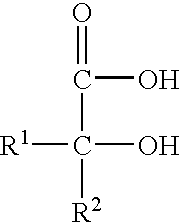Disinfecting nitrous acid compositions and process for using the same
a technology of nitrous acid and composition, which is applied in the direction of salicyclic acid active ingredients, anhydride/acid/halide active ingredients, biocide, etc., can solve the problems of limiting the application of nitrous acid in certain situations, corroding many metals used in the fabrication of medical and dental equipment, and corroding many metals, etc., to achieve minimal corrosion of medical equipment, significant antimicrobial activity, and rapid and broad spectrum of action
- Summary
- Abstract
- Description
- Claims
- Application Information
AI Technical Summary
Benefits of technology
Problems solved by technology
Method used
Image
Examples
example 1
[0066] This example illustrates the ability of six acidified nitrite solutions to destroy high levels of the Gram-positive organism Staphylococcus aureus (ATCC 29213), and to a degree consistent with the relative percentage of nitrous acid with respect to total nitrite in the solution. The mixed nitrite / acid solutions, their resulting pH values, and the relative percentages of nitrous acid in the solutions were as shown below. To prepare these solutions, equal parts of a 0.625% NaNO.sub.2 solution and increasing concentrations of malic acid solution were combined as follows:
3 Characteristics of Acidified Nitrite Solutions Sol'n No. NaNO.sub.2 Premix Malic Acid Premix pH of Mix Total Nitrite as Nitrous Acid 1 0.625% 2.25% 2.94 70% 2 0.625% 1.225% 3.12 60% 3 0.625% 0.812% 3.35 47% 4 0.625% 0.419% 3.54 37% 5 0.625% 0.263% 3.75 28% 6 0.625% 0.156% 3.90 21%
[0067] Procedure: A heavy suspension of the S. aureus was prepared in saline, and 1 part of the suspension was separately combined wi...
example 2
[0070] This example illustrates the ability of six acidified nitrite solutions to destroy high levels of the Gram-negative organism Escherichia coli (ATCC 25922). The procedure described in Example 1 was applied in this study as well, using aliquots of the same solutions described in the Table.
[0071] The results were as follows:
5 E. coli Cidal Data* Sol'n No. Recovered cfu Log Recovery Log Kill 1 2.7 .times. 10.sup.2 2.4 7.7 2 6.6 .times. 10.sup.4 4.8 5.3 3 9.0 .times. 10.sup.0 1.0 9.1 4 1.4 .times. 10.sup.1 1.1 9.0 5 9.9 .times. 10.sup.2 3.0 7.1 6 3.1 .times. 10.sup.3 3.5 6.6 *Inoculum suspension contained 1.2 .times. 10.sup.10 organisms (i.e., 10.1 logs).
[0072] In the case of this Gram-negative organism, the destruction of the inoculum was high in all solutions, apparently independent of pH and thus the relative amount of total nitrite existing as nitrous acid in this series of solutions. It is not known, at this point, whether this difference with respect to the observations in E...
example 3
[0073] This example illustrates the ability of six acidified nitrite solutions to destroy high levels of the Gram-negative organism Escherichia coli (ATCC 25922), following 20 days of storage of the mixed solutions at ambient temperatures prior to the testing. The procedure described in Example 1 was applied in this study as well, using aliquots of the same solutions that were evaluated in Examples 1 and 2. The results were as follows:
[0074] Results:
[0075] The data are presented in the following Table, in which the kills measured on the 20-day old solutions are compared with data obtained on the T=0 mixtures (in brackets).
6 E. coli Cidal Data on 20-day aged mixtures* Sol'n No. Recovered cfu Log Recovery Log Kill** 1 6.0 .times. 10.sup.1 1.8 9.2 [7.7] 2 1.5 .times. 10.sup.2 2.2 8.8 [5.3] 3 6.0 .times. 10.sup.0 0.8 10.2 [9.1] 4 >1 .times. 10.sup.5 >5.0 1 .times. 10.sup.6 >6.0 <5.0 [6.6] *Inoculum suspension contained 9.1 .times. 10.sup.10 organisms (i.e. 11.0 logs). **Bracketed data a...
PUM
| Property | Measurement | Unit |
|---|---|---|
| pKa | aaaaa | aaaaa |
| pKa | aaaaa | aaaaa |
| pH | aaaaa | aaaaa |
Abstract
Description
Claims
Application Information
 Login to View More
Login to View More - R&D
- Intellectual Property
- Life Sciences
- Materials
- Tech Scout
- Unparalleled Data Quality
- Higher Quality Content
- 60% Fewer Hallucinations
Browse by: Latest US Patents, China's latest patents, Technical Efficacy Thesaurus, Application Domain, Technology Topic, Popular Technical Reports.
© 2025 PatSnap. All rights reserved.Legal|Privacy policy|Modern Slavery Act Transparency Statement|Sitemap|About US| Contact US: help@patsnap.com



